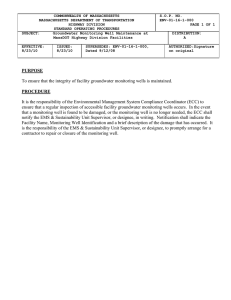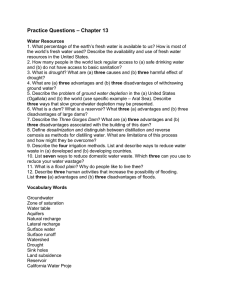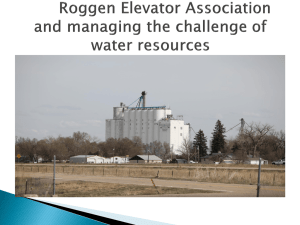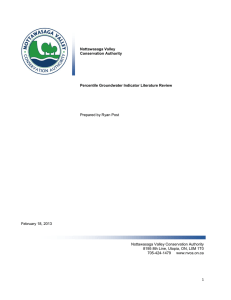Drought
advertisement
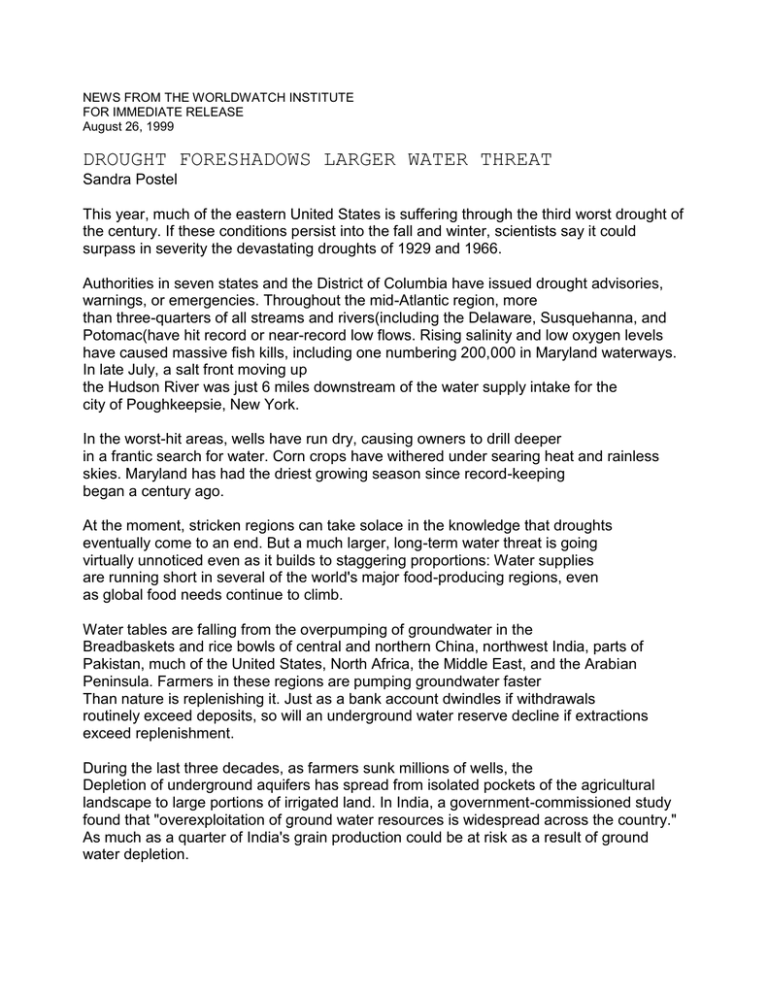
NEWS FROM THE WORLDWATCH INSTITUTE FOR IMMEDIATE RELEASE August 26, 1999 DROUGHT FORESHADOWS LARGER WATER THREAT Sandra Postel This year, much of the eastern United States is suffering through the third worst drought of the century. If these conditions persist into the fall and winter, scientists say it could surpass in severity the devastating droughts of 1929 and 1966. Authorities in seven states and the District of Columbia have issued drought advisories, warnings, or emergencies. Throughout the mid-Atlantic region, more than three-quarters of all streams and rivers(including the Delaware, Susquehanna, and Potomac(have hit record or near-record low flows. Rising salinity and low oxygen levels have caused massive fish kills, including one numbering 200,000 in Maryland waterways. In late July, a salt front moving up the Hudson River was just 6 miles downstream of the water supply intake for the city of Poughkeepsie, New York. In the worst-hit areas, wells have run dry, causing owners to drill deeper in a frantic search for water. Corn crops have withered under searing heat and rainless skies. Maryland has had the driest growing season since record-keeping began a century ago. At the moment, stricken regions can take solace in the knowledge that droughts eventually come to an end. But a much larger, long-term water threat is going virtually unnoticed even as it builds to staggering proportions: Water supplies are running short in several of the world's major food-producing regions, even as global food needs continue to climb. Water tables are falling from the overpumping of groundwater in the Breadbaskets and rice bowls of central and northern China, northwest India, parts of Pakistan, much of the United States, North Africa, the Middle East, and the Arabian Peninsula. Farmers in these regions are pumping groundwater faster Than nature is replenishing it. Just as a bank account dwindles if withdrawals routinely exceed deposits, so will an underground water reserve decline if extractions exceed replenishment. During the last three decades, as farmers sunk millions of wells, the Depletion of underground aquifers has spread from isolated pockets of the agricultural landscape to large portions of irrigated land. In India, a government-commissioned study found that "overexploitation of ground water resources is widespread across the country." As much as a quarter of India's grain production could be at risk as a result of ground water depletion. Likewise, overpumping is widespread in China's north-central plain, which produces some 40 percent of the nation's grain. Across a wide area, water tables have been dropping 1 to 1.5 meters a year, even as the nation's water demands continue to climb. In the United States, one-fifth of all irrigated land gets water from a vast underground reserve known as the Ogallala. One of the planet's greatest aquifers, it spans portions of eight states, from South Dakota in the north to Texas in the south. In its southern reaches, the Ogallala gets very little replenishment from rainfall and decades of heavy pumping have taken a toll. The volume of water depleted to date is equal to the annual flow of 18 Colorado Rivers. All told, the world's farmers are racking up an annual water deficit of some 160 billion cubic meters-the amount used to produce nearly 10 percent of the world's grain. The overpumping of groundwater cannot continue indefinitely. Eventually, the wells run dry, or it becomes too expensive to pump from greater depths. Even if groundwater depletion was the only water problem in our farming regions, we would have ample cause for concern; but it is not. Many major rivers now run dry for large portions of the year-including the Yellow in China, the Indus in Pakistan, the Ganges in South Asia, and the Colorado in the American Southwest. Worldwide, one in five acres of irrigated land is damaged by a buildup of salt that is slowly sapping the soil's fertility. Cities and farms now compete for scarce water, as do neighboring countries that depend on the same river. Meanwhile, populations continue to grow fastest in some of the world's most water-short regions. The number of people living in water-stressed countries is projected to climb from 470 million to 3 billion by 2025. With this number of people living in countries lacking enough water to be food self-sufficient, competition for grain imports will increase. Whether the United States, Europe, and other exporters will produce sufficient surpluses to meet those import demands is only half the issue. The other half is whether the exports will be offered at a price that poor, food-importing nations-especially those in South Asia and sub-Saharan Africa-can afford. Hanging over these worsening water problems is the prospect of climate change. One likely effect of higher temperatures and more rapid melting of winter snowpacks is a reduction in available water supplies during the summer months, when farms and cities need water most. In addition, for some period of time, our reservoirs and water systems will be poorly matched to altered rainfall and river flow patterns(creating additional vulnerabilities in our water and food systems. Water scarcity is now the single biggest threat to global food production. Only by taking action now to conserve the water supplies in our major crop-producing regions can we secure enough water to satisfy future food needs.

